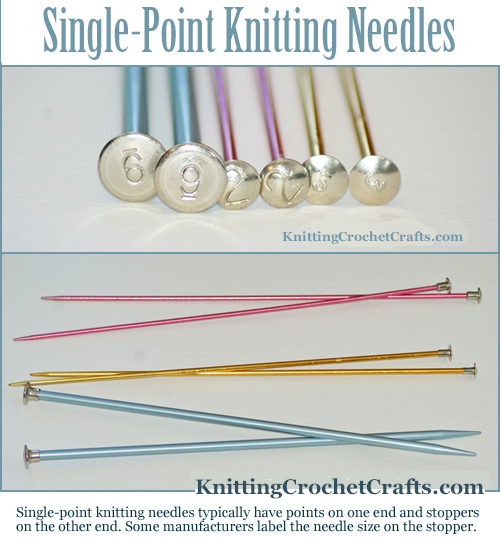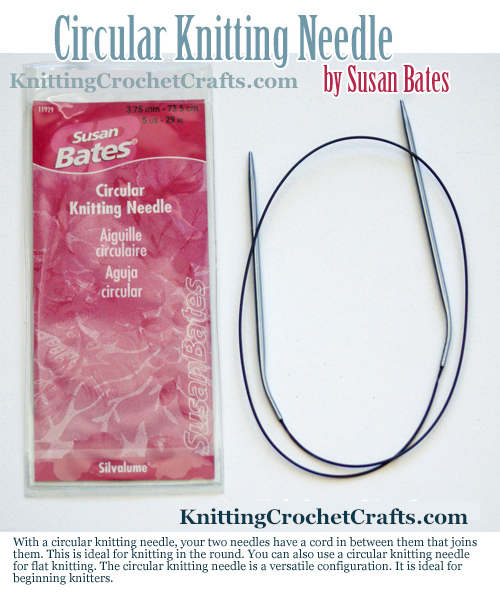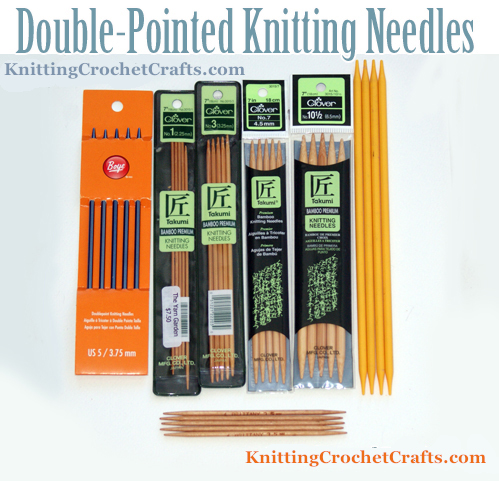Which Knitting Needles Does a Beginner Need? Read On to Find the Answer…
If you’re new to knitting, it can be perplexing to figure out which knitting needles you should use for the project you have in mind. Knitting needles come in a variety of materials and configurations, and it seems there are unlimited types of knitting needles to choose from. This brief guide will help you sort out when it’s appropriate to use each different type of knitting needles. I’ll also give you some tips on which types of knitting needles a beginning knitter might want to include in her or his craft supplies stash.
The Materials Knitting Needles Are Made Out Of
Knitting needles can be made out of a broad variety of different materials. Some of the most common are bamboo, aluminum and plastic. You’ll also find knitting needles made out of premium wood such as birch. Other types of metal needles are available as well.
Beginners are likely to enjoy knitting with bamboo knitting needles. This is because bamboo needles tend to be less slippery than either aluminum or plastic. Sometimes beginners have problems with their stitches sliding all over the place, which can be really frustrating. One possible solution to that problem is to use bamboo knitting needles; bamboo can really cut down on the problem of slippery stitches.
Once you’re past the awkward beginner phase, if you want to knit fast, you might find that you prefer aluminum needles. There is less friction when you knit with aluminum than there is when you knit with bamboo.
Your climate might also influence which material you’d want to choose for your needles. Aluminum needles heat up in hot weather, and they get really cold in cold weather. This is not such an issue with bamboo needles. For that reason alone, I much prefer knitting with bamboo needles — because I spend a lot of time knitting outdoors and in environments that are not temperature controlled.
Knitting Needle Sizes
When selecting knitting needles, there are several different aspects you’ll need to pay attention to. One is the length of the knitting needle. The other is the knitting needle size. This can be expressed in millimeters, which is the safest approach; or it can be expressed as a US size number or a UK size number. In the USA, knitting needle sizes start small for thin needles and get bigger as the needles get thicker. Thin knitting needles correspond to thinner yarn weights. Thicker, fatter knitting needles correspond to thicker, chunkier, heftier yarn weights.
Knitting Needle Types
Straight, Single-Point Knitting Needles

Single Point Knitting Needles
Straight, single-point knitting needles are typically long and straight with a point on one end and a stopper on the other end. They come in a variety of lengths, with a couple of the most popular lengths being 10 inches and 14 inches. The longer the needle, the more arm strength it takes to knit with them, and the more cumbersome the knitting tends to become,
Knitters often reach for straight, single-point knitting needles for small projects that are to be knitted flat. One example would be flat, rectangular scarves.
This type of knitting needle’s main advantage is that it tends to be cheap. Ready availability is another advantage. Big box retailers including Walmart, JoAnn and Michael’s stock and sell this type of knitting needles .
My opinion: Most of the time, I’d advise beginners to skip buying these knitting needles. Anything you can make with these, you can also make on circular knitting needles – and I find circular knitting needles to be much better, for a variety of reasons. For starters, it’s easier to work with circular needles (I’ll get into why in the section about circular knitting needles, below).
It’s also a lot easier to keep track of ONE circular needle than it is to keep track of a pair of single-points. I often buy secondhand knitting needles, and in my experience, it’s really common for knitters to lose some of their single points (as evidenced by the fact that each box of single points I’ve purchased has contained some oddball single points where the mates were missing). If you’re a super organized person, this might not be an issue for you. It helps if you have good craft organizers for storing your knitting needles in. Even so, definitely be aware that losing single-point needles is an issue for lots of other knitters.
Circular Knitting Needles

Susan Bates Circular Knitting Needle — With a circular knitting needle, your two needles have a cord in between them that joins them. This is ideal for knitting in the round. You can also use a circular knitting needle for flat knitting. The circular knitting needle is a versatile configuration. It is ideal forbeginning knitters.
Circular knitting needles are short knitting needles that are connected by a cord. This means you only have to keep track of one object instead of two. This is a versatile type of knitting needle. You can use circular needles for knitting in the round, and you can also use them for flat knitting.
Circular knitting needles tend to be more expensive than single-point knitting needles, but I find them to be well worth the slightly extra expense.
In my opinion, the main advantage of the circular needle is that it’s much easier to knit with. When you knit with single-point knitting needles, most of the time you’re knitting, you have to bear the weight of your project with your arms. When you knit with a circular knitting needle, most of the weight of the project rests in your lap. So if sculpting your arm muscles isn’t one of your knitting goals, circular knitting needles are clearly preferable in that regard.
Another advantage is that you can accommodate a wider range of project sizes on circular knitting needles. Single-point knitting needles put greater limitations on your project size.
Circular knitting needles come in a range of sizes and lengths. You’ll have to pay attention to both bits of information.
The length of the circular needle dictates the circumference of the project you can knit when you’re knitting in the round. Typically, you’d want to choose a 16-inch length for knitting hats. Shawls and wraps can require circular knitting needles in a broad range of sizes, but it isn’t uncommon to use 24-inch, 29-inch, 34-inch, 36-inch, 40-inch or 60-inch circular needles for knitting shawls. Sweaters typically require circular knitting needles in at least one size and possibly a range of sizes.
If you’re trying to decide whether you absolutely need to buy a new circular knitting needle for a specific project, take a look at the pattern notes. If the project is knitted in the round, it’s likely to be important for you to use the exact length of circular knitting needle recommended in the pattern – so do buy that length of needle if you’re serious about making that particular project.
If the project is knitted flat, you can typically get away with using a circular knitting needle that’s somewhat longer than the needle length recommended in the pattern. So, if you have a circular needle that’s the right size but the length is longer, you may be able to use it successfully if your project is knitted flat. However, you’ll most likely want to avoid using a circular needle that’s significantly shorter than the recommended length. This is because you want to avoid having your knitting bunch up excessively on a too-short needle, which can be annoying.
Interchangeable Circular Knitting Needles
It can get costly and aggravating to have to buy and store bunches of different circular needles. There’s a practical solution: Interchangeable circular knitting needles. This option allows you to mix and match needle tips with different cord sizes, saving you massive headaches in having to buy a new knitting needle every time you begin a different type of project.
The only real downside I’m aware of with interchangeables is the upfront cost to buy a good set of them. However, it is TOTALLY worth the cost to get a good set. This solution saves bunches of space and, in the long run, a ton of money. For the serious knitter, it’s a completely worthwhile investment. But for the beginning knitter, I’d advise waiting to make a sizable investment in interchangeables until you’re positive knitting is going to continue to be a part of your life.
There’s one exception: Knitpicks makes “Try It” sets of interchangeable knitting needles that don’t require a big upfront investment. I haven’t tried the set myself to give you any specifics on that particular product, but if I wish I had known about it before I bought myself a hodgepodge of different needles. If I were getting started with knitting, I’d definitely want to give that set a try.
Double-Pointed Knitting Needles

Double-point knitting needles (DPNs) typically have points on both ends. DPNs do not have any stoppers. This is because you need to be able to move stitches from one DPN to another from both sides of each needle. DPNs usually come in sets of 4-5 needles.
You’d typically want to use double-pointed knitting needles (abbreviated DPNs) for knitting small tubes. If you want to knit socks or mittens, this is the type of knitting needles you’d probably reach for. They’re also a requirement for knitting some (but not all) types of hats. Some sweater patterns require DPNs for knitting the sleeves or other details. DPNs can also be helpful at times when you want to knit a small tubular piece for other purposes, perhaps for a scarf, bag or other such pieces.
DPNs typically come in sets of 4 or 5 needles. Lengths vary. 7 inches is a popular size, but they can also be longer. You’ll find DPNs made of bamboo, birch, aluminum, plastic and other materials.
DPNs are not essential in the absolute beginner’s craft supply stash. However, they’re well worth buying once you’ve determined that knitting is definitely your thing.
Cable Needles
If you want to knit cables, you’ll need at least one pair of circular, straight or double-pointed knitting needles PLUS at least one cable needle. The cable needle is useful for holding and transferring stitches as you create your cables.
Which Knitting Needles Should a Beginner Start Out With?
In general, I think the smartest approach is to choose a beginner-level knitting pattern that you want to make. The pattern will recommend a yarn and needle size to work with. You can start by buying the recommended needle size and making a gauge swatch. If you are able to get the correct gauge using the recommended needles, those are the right needles to start out with. If you can’t get the right gauge with those needles, at that point, you’d want to buy the next size up or down, depending on the situation. If you’re knitting more stitches per inch than the recommended gauge, you’ll need a bigger needle. And if you’re knitting fewer stitches per inch than the recommended gauge, try a smaller needle.
What Size Knitting Needles Should a Beginning Knitter Buy?
I don’t feel comfortable recommending a specific “best knitting needle size for beginners”. That’s because there are waaaaayyyyyyyy too many variables. Instead, I think it’s better for you to choose a beginner-level knitting pattern you LOVE and want to knit. Then simply buy the recommended knitting needles you need for making that pattern.
So there you have it: Those are the basics that a beginner needs to know about knitting needles. I hope you find this information helpful as you select the knitting needles to use for your first few knitting projects.
By Amy Solovay
This page was last updated on 5-24-2021